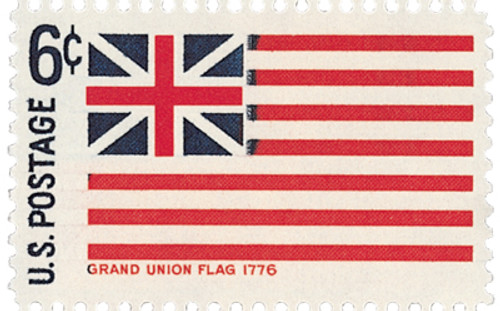
# 1345-54 - 1968 6c Historic American Flags
U.S. #1345-54
1968 Historic Flags Series
Se-tenant
Issue Date: July 4, 1968
City: Pittsburgh, PA
Printed By: Bureau of Engraving and Printing
Printing Method: Giori Press
Perforations: 11
Color: Multicolored
Set of 10 attached stamps showcases historic flags that have flown over the United States in the early days of America’s history.
Fort Moultrie: Also known as the Liberty Flag, this was carried by colonists when the British attacked Sullivan’s Island in South Carolina. The flag was shot from its staff and Sergeant William Jasper ran out in the open to rescue it. The colonists’ victory saved Charleston from invasion, and the fort on the island was named for the commander, William Moultrie.
Fort McHenry: This 15-star and 15-stripe flag is the inspiration behind Francis Scott Key’s “The Star-Spangled Banner.” The flag flew over Fort McHenry, which guarded Baltimore, Maryland’s harbor, during a War of 1812 British naval bombardment. After a long night of fighting, Key found our “flag was still there.” The original Fort McHenry flag now hangs in the Smithsonian Institution.
Washington’s Cruisers: In 1775, George Washington outfitted seven ships to sail in the waters around Boston to prevent the British from receiving supplies. The colonial ships flew a white flag with a pine tree, which represented freedom. These ships were the first Navy of the United States.
Bennington: Colonists from New Hampshire, Massachusetts, and Vermont defeated the British at the Battle of Bennington, Vermont. This flag was made to commemorate the victory. The large “76” in the field of blue makes it easily identifiable. The top and bottom stripes are white, rather than the traditional red.
Rhode Island: The 13-star flag was carried by the First Rhode Island Regiment at the Battle of Yorktown. The anchor and motto had been used by Rhode Island since 1647.
First Stars and Stripes: The first official 13-star, 13-stripe flag was authorized by the Continental Congress on June 14, 1777.
Bunker Hill: The colonists carried this flag during the battle for Boston. Though the Battle of Bunker Hill was a defeat for the colonists, British losses were heavy.
Grand Union: Also known as the Continental Colors, this flag was the first national flag of the United States. The 13 stripes represent the colonies, while the British Union Flag reflected the desire by many to remain loyal to England.
Philadelphia Light Horse Troop: This troop escorted General George Washington from Philadelphia to Massachusetts to take command of the Continental Army. They also carried their flag in the battles of Princeton, Brandywine, Germantown, and Trenton.
1st Navy Jack: This flag was the flown by the Continental Navy. The rattlesnake was a symbol of resistance to British rule.
U.S. #1345-54
1968 Historic Flags Series
Se-tenant
Issue Date: July 4, 1968
City: Pittsburgh, PA
Printed By: Bureau of Engraving and Printing
Printing Method: Giori Press
Perforations: 11
Color: Multicolored
Set of 10 attached stamps showcases historic flags that have flown over the United States in the early days of America’s history.
Fort Moultrie: Also known as the Liberty Flag, this was carried by colonists when the British attacked Sullivan’s Island in South Carolina. The flag was shot from its staff and Sergeant William Jasper ran out in the open to rescue it. The colonists’ victory saved Charleston from invasion, and the fort on the island was named for the commander, William Moultrie.
Fort McHenry: This 15-star and 15-stripe flag is the inspiration behind Francis Scott Key’s “The Star-Spangled Banner.” The flag flew over Fort McHenry, which guarded Baltimore, Maryland’s harbor, during a War of 1812 British naval bombardment. After a long night of fighting, Key found our “flag was still there.” The original Fort McHenry flag now hangs in the Smithsonian Institution.
Washington’s Cruisers: In 1775, George Washington outfitted seven ships to sail in the waters around Boston to prevent the British from receiving supplies. The colonial ships flew a white flag with a pine tree, which represented freedom. These ships were the first Navy of the United States.
Bennington: Colonists from New Hampshire, Massachusetts, and Vermont defeated the British at the Battle of Bennington, Vermont. This flag was made to commemorate the victory. The large “76” in the field of blue makes it easily identifiable. The top and bottom stripes are white, rather than the traditional red.
Rhode Island: The 13-star flag was carried by the First Rhode Island Regiment at the Battle of Yorktown. The anchor and motto had been used by Rhode Island since 1647.
First Stars and Stripes: The first official 13-star, 13-stripe flag was authorized by the Continental Congress on June 14, 1777.
Bunker Hill: The colonists carried this flag during the battle for Boston. Though the Battle of Bunker Hill was a defeat for the colonists, British losses were heavy.
Grand Union: Also known as the Continental Colors, this flag was the first national flag of the United States. The 13 stripes represent the colonies, while the British Union Flag reflected the desire by many to remain loyal to England.
Philadelphia Light Horse Troop: This troop escorted General George Washington from Philadelphia to Massachusetts to take command of the Continental Army. They also carried their flag in the battles of Princeton, Brandywine, Germantown, and Trenton.
1st Navy Jack: This flag was the flown by the Continental Navy. The rattlesnake was a symbol of resistance to British rule.


















